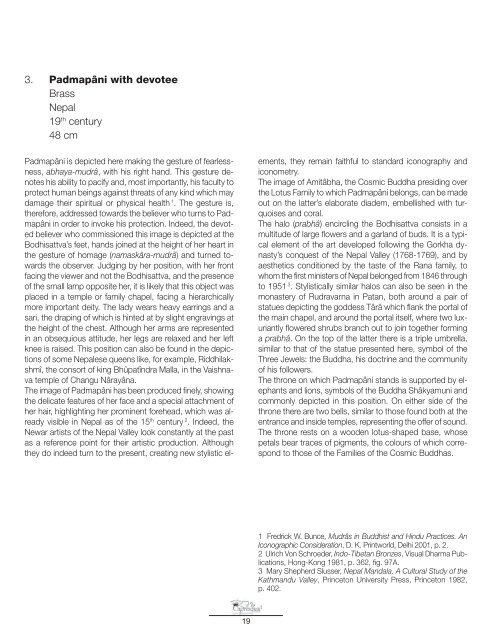Images of Devotion - capriaquar.it
Images of Devotion - capriaquar.it
Images of Devotion - capriaquar.it
You also want an ePaper? Increase the reach of your titles
YUMPU automatically turns print PDFs into web optimized ePapers that Google loves.
3. Padmapâni w<strong>it</strong>h devotee<br />
Brass<br />
Nepal<br />
19 th century<br />
48 cm<br />
Padmapâni is depicted here making the gesture <strong>of</strong> fearlessness,<br />
abhaya-mudrâ, w<strong>it</strong>h his right hand. This gesture denotes<br />
his abil<strong>it</strong>y to pacify and, most importantly, his faculty to<br />
protect human beings against threats <strong>of</strong> any kind which may<br />
damage their spir<strong>it</strong>ual or physical health 1 . The gesture is,<br />
therefore, addressed towards the believer who turns to Padmapâni<br />
in order to invoke his protection. Indeed, the devoted<br />
believer who commissioned this image is depicted at the<br />
Bodhisattva’s feet, hands joined at the height <strong>of</strong> her heart in<br />
the gesture <strong>of</strong> homage (namaskâra-mudrâ) and turned towards<br />
the observer. Judging by her pos<strong>it</strong>ion, w<strong>it</strong>h her front<br />
facing the viewer and not the Bodhisattva, and the presence<br />
<strong>of</strong> the small lamp oppos<strong>it</strong>e her, <strong>it</strong> is likely that this object was<br />
placed in a temple or family chapel, facing a hierarchically<br />
more important de<strong>it</strong>y. The lady wears heavy earrings and a<br />
sari, the draping <strong>of</strong> which is hinted at by slight engravings at<br />
the height <strong>of</strong> the chest. Although her arms are represented<br />
in an obsequious att<strong>it</strong>ude, her legs are relaxed and her left<br />
knee is raised. This pos<strong>it</strong>ion can also be found in the depictions<br />
<strong>of</strong> some Nepalese queens like, for example, Riddhilakshmî,<br />
the consort <strong>of</strong> king Bhûpatîndra Malla, in the Vaishnava<br />
temple <strong>of</strong> Changu Nârayâna.<br />
The image <strong>of</strong> Padmapâni has been produced finely, showing<br />
the delicate features <strong>of</strong> her face and a special attachment <strong>of</strong><br />
her hair, highlighting her prominent forehead, which was already<br />
visible in Nepal as <strong>of</strong> the 15 th century 2 . Indeed, the<br />
Newar artists <strong>of</strong> the Nepal Valley look constantly at the past<br />
as a reference point for their artistic production. Although<br />
they do indeed turn to the present, creating new stylistic el-<br />
19<br />
ements, they remain fa<strong>it</strong>hful to standard iconography and<br />
iconometry.<br />
The image <strong>of</strong> Am<strong>it</strong>âbha, the Cosmic Buddha presiding over<br />
the Lotus Family to which Padmapâni belongs, can be made<br />
out on the latter’s elaborate diadem, embellished w<strong>it</strong>h turquoises<br />
and coral.<br />
The halo (prabhâ) encircling the Bodhisattva consists in a<br />
mult<strong>it</strong>ude <strong>of</strong> large flowers and a garland <strong>of</strong> buds. It is a typical<br />
element <strong>of</strong> the art developed following the Gorkha dynasty’s<br />
conquest <strong>of</strong> the Nepal Valley (1768-1769), and by<br />
aesthetics cond<strong>it</strong>ioned by the taste <strong>of</strong> the Rana family, to<br />
whom the first ministers <strong>of</strong> Nepal belonged from 1846 through<br />
to 1951 3 . Stylistically similar halos can also be seen in the<br />
monastery <strong>of</strong> Rudravarna in Patan, both around a pair <strong>of</strong><br />
statues depicting the goddess Târâ which flank the portal <strong>of</strong><br />
the main chapel, and around the portal <strong>it</strong>self, where two luxuriantly<br />
flowered shrubs branch out to join together forming<br />
a prabhâ. On the top <strong>of</strong> the latter there is a triple umbrella,<br />
similar to that <strong>of</strong> the statue presented here, symbol <strong>of</strong> the<br />
Three Jewels: the Buddha, his doctrine and the commun<strong>it</strong>y<br />
<strong>of</strong> his followers.<br />
The throne on which Padmapâni stands is supported by elephants<br />
and lions, symbols <strong>of</strong> the Buddha Shâkyamuni and<br />
commonly depicted in this pos<strong>it</strong>ion. On e<strong>it</strong>her side <strong>of</strong> the<br />
throne there are two bells, similar to those found both at the<br />
entrance and inside temples, representing the <strong>of</strong>fer <strong>of</strong> sound.<br />
The throne rests on a wooden lotus-shaped base, whose<br />
petals bear traces <strong>of</strong> pigments, the colours <strong>of</strong> which correspond<br />
to those <strong>of</strong> the Families <strong>of</strong> the Cosmic Buddhas.<br />
1 Fredrick W. Bunce, Mudrâs in Buddhist and Hindu Practices. An<br />
Iconographic Consideration, D. K. Printworld, Delhi 2001, p. 2.<br />
2 Ulrich Von Schroeder, Indo-Tibetan Bronzes, Visual Dharma Publications,<br />
Hong-Kong 1981, p. 362, fig. 97A.<br />
3 Mary Shepherd Slusser, Nepal Mandala. A Cultural Study <strong>of</strong> the<br />
Kathmandu Valley, Princeton Univers<strong>it</strong>y Press, Princeton 1982,<br />
p. 402.


